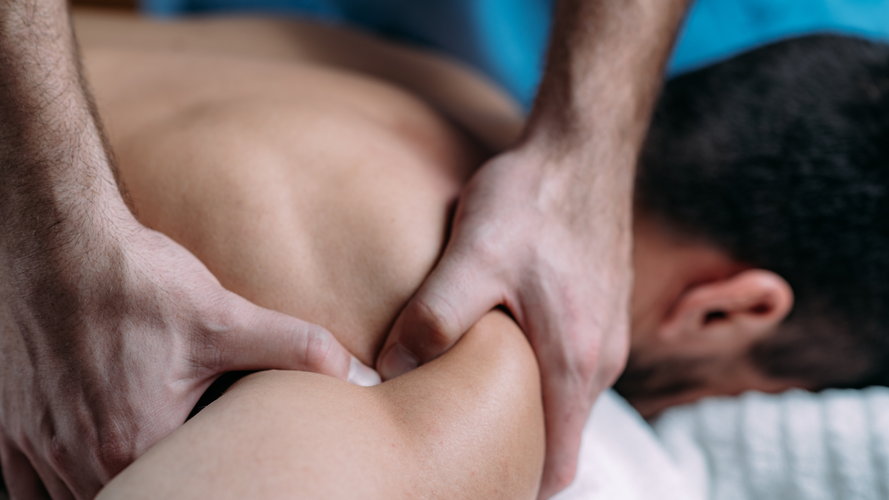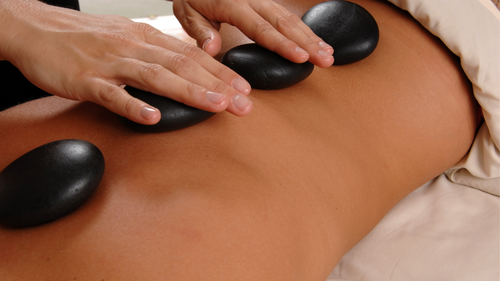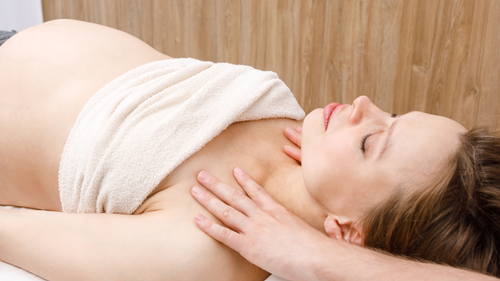Finding the right type of massage can make all the difference when you’re seeking stress relief pain reduction or performance support. This blog compares the most popular massage types describes what each method targets and shows how to match your goals with the right approach so you get the best value from your session.

The Most Popular Massages – Find Your Perfect Match!
Denise Leslie
Massages offer a rejuvenating escape from the stresses of daily life, soothing both the body and mind. With various types of popular massages available - from Swedish to deep tissue - each offers its own unique benefits. When you understand what each massage offers, you can communicate better with your massage therapist, ensuring you get exactly what you need to feel.
Whether you seek relaxation, pain relief, or simply a moment of blissful indulgence, there's a massage tailored just for you. So, take a moment to explore popular massages and discover the one that resonates most with your spirit.
After all, self-care is not a luxury but a vital investment in your well-being.
Swedish Massage
One of the most common types of massage is Swedish massage. Swedish massage is the foundation of many other types of massage and is based on anatomy and physiology. Depending on your massage goals, the strokes may be gentle or vigorous. It's known for its soothing effects, making it great for reducing stress and tension in the body. During all Swedish massages, your massage therapist will use massage oil to manipulate the skin, muscles, tendons, and ligaments to release tension. Swedish massage is a great choice if you have never received a massage before.
Ideal for:
Relaxation and stress relief
Improving circulation
Alleviating muscle tension and stiffness
Enhancing flexibility and range of motion
Promoting overall well-being
Benefits:
Induces deep relaxation
Reduces stress and anxiety
Improves blood circulation
Relieves muscle tension and soreness
Increases flexibility and mobility
Boosts immune function
Enhances mood and mental clarity
Deep Tissue Massage
Deep tissue massage uses many techniques similar to Swedish massage, focusing on the deeper tissue of your muscles. Deep tissue massage aims to release the tension or knots in your body. This means that the pressure is generally more intense and can be uncomfortable, though it shouldn’t be painful. Pain makes your muscles tense, which is counterproductive to your massage, so it is important to communicate with your masseuse if the massage gets too intense. Deep tissue massage is best for people who have a lot of muscle tension.
Ideal for:
Addressing chronic muscle tension and knots
Providing relief from deep muscle pain and soreness
Improving posture and flexibility
Rehabilitating injured muscles
Alleviating pain related to specific conditions like sciatica or fibromyalgia
Benefits:
Targets deep layers of muscle and connective tissue
Releases chronic tension and adhesions
Increases blood flow to targeted areas, aiding in muscle repair and recovery
Promotes better posture and alignment
Helps break up scar tissue from injuries or surgeries
Can provide relief from chronic pain conditions
Enhances overall mobility and range of motion
Relaxation Massage
Relaxation massages use the same techniques as Swedish massage but tend to be slower and gentler than other massages. The massage therapist uses lighter pressure and a slower pace because the primary goal of a relaxation massage is to relax you. The therapist will not get into underlying muscle tension like deep tissue massage does because that can be uncomfortable. A relaxation massage is best for newcomers or people who want to unwind and de-stress with their massage.
Ideal for:
Reducing stress and promoting relaxation
Relieving tension and promoting a sense of calmness
Improving sleep quality and promoting better rest
Rejuvenating the body and mind
Offering a gentle and soothing experience
Benefits:
Induces deep relaxation and reduces anxiety
Lowers levels of stress hormones such as cortisol
Improves mood and overall sense of well-being
Enhances sleep quality and promotes restful sleep
Reduces muscle tension and promotes better circulation
Boosts immune function by reducing stress levels

Sports Massage
Sports massage is a type of massage specifically designed to help athletes keep their bodies in optimal condition and prevent injuries. It is performed before a competition to prime the body, during a competition for added support, and after to aid in muscle recovery. Among the popular massages, you may think this was designed for athletes. However, you don’t have to be an athlete to benefit from it. Anyone with chronic pain, injury, or issues with their range of motion can benefit from sports massage.
Ideal for:
Athletes and active individuals
Preparing for or recovering from physical activity or sports events
Addressing specific muscle imbalances or injuries related to sports or exercise
Enhancing athletic performance and preventing injuries
Benefits:
Improves flexibility, mobility, and range of motion
Reduces muscle soreness and fatigue
Helps prevent injuries by identifying and addressing muscle imbalances
Promotes faster recovery from intense physical activity or workouts
Enhances circulation and lymphatic drainage, aiding in the removal of metabolic waste products
Increases awareness of body mechanics and movement patterns
Provides targeted treatment for sports-related injuries such as strains, sprains, and tendonitis
Medical Massage
Medical massage is used to treat health conditions. There is no one technique for it; instead, the massage therapist alters the techniques and movements based on the client's specific health condition. Most of the time, you need a prescription for a medical massage to ensure that your insurance will cover it. Medical massage is a wonderful option for people with chronic illnesses, particularly those that involve chronic pain.
Ideal for:
Individuals with specific medical conditions or injuries
Addressing musculoskeletal issues, such as chronic pain or injury rehabilitation
Complementing traditional medical treatments or physical therapy
Providing targeted relief for conditions like carpal tunnel syndrome, sciatica, or fibromyalgia
Benefits:
Alleviates chronic pain and discomfort associated with medical conditions
Improves range of motion and flexibility
Reduces inflammation and swelling
Enhances circulation, promoting tissue healing and recovery
Releases muscle tension and reduces muscle spasms
Improves posture and alignment, reducing strain on the body
Supports overall physical well-being and quality of life

Hot Stone Massage
Hot stone massage originated centuries ago but became among the popular massages in its latest form in the early 1990s. During a hot stone massage, the massage therapist uses round, smooth, warm stones as extensions of their hands. They may rub the stones on your body or strategically place them on pressure points. The stones warm up your muscles, making it a very relaxing activity. If you have tight muscles, a hot stone massage may help reduce your tension and allow the therapist to work more deeply in your muscles.
Ideal for:
Promoting relaxation and reducing stress
Alleviating muscle tension and stiffness
Improving circulation and blood flow
Providing relief from chronic pain conditions
Enhancing overall well-being and tranquility
Benefits:
Induces deep relaxation and calms the nervous system
Increases blood flow to targeted areas, promoting healing and tissue repair
Reduces muscle tension and stiffness through heat therapy
Relieves pain associated with conditions like arthritis, fibromyalgia, and chronic back pain
Enhances flexibility and range of motion
Releases toxins from the body and boosts immune function
Improves sleep quality and promotes feelings of comfort and well-being
Thai Massage
Been practiced for centuries. Unlike other types of massage, Thai Massage is performed on a floor mat rather than a table, and recipients remain fully clothed throughout the session. During a Thai Massage, the practitioner uses a combination of rhythmic compressions, gentle stretching, and passive yoga-like movements to release tension, improve flexibility, and promote overall relaxation. The therapist applies pressure along energy lines and acupressure points, known as "sen lines," to stimulate the body's natural healing processes.
Ideal for:
Increasing flexibility and range of motion
Alleviating muscle tension and stiffness
Improving circulation and lymphatic drainage
Promoting relaxation and reducing stress
Balancing energy levels and enhancing overall well-being
Benefits:
Utilizes gentle stretching and deep pressure techniques to release tension and improve flexibility
Stimulates circulation, aiding in the removal of toxins and promoting healing
Targets specific energy lines and acupressure points to restore balance and vitality
Relieves pain and discomfort associated with chronic conditions such as back pain, headaches, and arthritis
Promotes deep relaxation and mental clarity, reducing stress and anxiety
Boosts immune function and supports overall physical and emotional health
Shiatsu Massage
Shiatsu Massage is a Japanese healing therapy that involves applying pressure to specific points on the body to promote relaxation, alleviate pain, and enhance overall well-being. The word "Shiatsu" translates to "finger pressure" in Japanese, highlighting the technique's emphasis on using fingers, thumbs, palms, and sometimes elbows and knees to apply pressure. One of the key principles of Shiatsu Massage is the belief in the body's natural ability to heal itself. By applying pressure to specific points along the body's energy pathways, known as meridians, Shiatsu aims to balance the flow of energy, or "qi," within the body.
Ideal for:
Alleviating muscle tension and stiffness
Promoting relaxation and reducing stress
Improving circulation and energy flow
Balancing the body's energy pathways
Supporting overall health and well-being
Benefits:
Utilizes finger pressure and gentle stretching techniques to release tension and restore balance
Stimulates circulation, aiding in the removal of toxins and promoting healing
Targets specific acupressure points to alleviate pain and discomfort
Promotes deep relaxation and mental clarity, reducing stress and anxiety
Boosts immune function and supports the body's natural healing processes
Enhances energy levels and vitality, promoting a sense of overall well-being

Prenatal Massage
Prenatal Massage is a specialized form of massage therapy designed to support the health and well-being of pregnant individuals. It is tailored to address the unique needs and concerns that arise during pregnancy, providing relief from common discomforts and promoting relaxation and overall wellness. One of the primary benefits of Prenatal Massage is its ability to alleviate pregnancy-related physical discomforts. As the body undergoes significant changes to accommodate the growing baby, pregnant individuals may experience a range of symptoms such as back pain, sciatica, muscle tension, and swelling. Prenatal Massage techniques are specifically adapted to address these discomforts, providing relief and promoting comfort throughout pregnancy.
Ideal for:
Providing relief from pregnancy-related discomforts such as back pain, hip pain, and swollen feet
Reducing stress and anxiety during pregnancy
Promoting relaxation and improving sleep quality
Addressing muscle tension and soreness associated with the changes in the body during pregnancy
Supporting overall prenatal health and well-being
Benefits:
Alleviates pregnancy-related discomforts such as back pain, sciatica, and headaches
Reduces stress and anxiety levels, promoting a sense of calmness and relaxation
Improves sleep quality by easing discomfort and promoting relaxation
Relieves muscle tension and soreness through gentle massage techniques adapted for pregnancy
Enhances circulation, reducing swelling and promoting overall well-being
Provides emotional support and nurtures the connection between mother and baby
Aromatherapy Massage
Aromatherapy Massage combines the therapeutic benefits of massage with the use of essential oils extracted from plants, flowers, and herbs. These essential oils are chosen for their specific aromatic properties, which can profoundly affect the body and mind. During an Aromatherapy Massage, the massage therapist incorporates the use of essential oils into the massage session. The oils are typically diluted in a carrier oil and applied to the skin through gentle massage strokes, allowing their aroma to be inhaled and absorbed into the body.
Ideal for:
Promoting relaxation and reducing stress
Alleviating muscle tension and soreness
Enhancing mood and emotional well-being
Improving sleep quality and reducing insomnia
Supporting overall health and wellness
Benefits:
Utilizes the therapeutic properties of essential oils to enhance the massage experience
Relaxes the mind and body through inhalation of aromatic oils
Reduces stress and anxiety levels, promoting a sense of calmness and tranquility
Alleviates muscle tension and soreness with the combined effects of massage and aromatherapy
Improves mood and emotional well-being by uplifting or calming the senses, depending on the essential oils used
Enhances sleep quality and promotes restful sleep by creating a relaxing environment conducive to relaxation
Which Type of Massage Are You Considering?
Understanding different types of massage is important because it helps you find the one that suits you best! If you're feeling stressed and need to relax, there's a massage for that. If your muscles are sore and need some relief, there's a massage for that, too. By knowing your options among the popular massages, you can choose the one that makes you feel amazing and helps you take care of yourself.
You can talk to your massage therapist about what you like and what you need so you can get the most out of your experience. Determine what you hope to achieve with the massage. Are you looking for relaxation, pain relief, stress reduction, or something else? Knowing your goals will help narrow down your options.
Frequently Asked Questions
Deep tissue massage and Swedish massage are two of the most popular massage techniques, each serving different purposes. Swedish massage is gentler and focuses on relaxation, while deep tissue massage targets deeper layers of muscle to help reduce chronic tension and improve range of motion.
A full-body massage addresses all major areas for overall relaxation, while a targeted massage focuses on specific problem areas. It is ideal for tension, pain, or injuries requiring deeper or more localized work.
Each massage type offers unique benefits, from relaxation and stress relief to pain reduction and improved athletic performance. Whether Swedish, deep tissue, sports, or prenatal, each approach supports wellness in different ways.
Gentle therapeutic techniques that promote relaxation can help reduce stress, which indirectly supports heart health. Deep tissue and sports massage have also shown positive effects by improving circulation and reducing muscle strain.
Sports massage improves flexibility, reduces muscle soreness, enhances recovery, and helps prevent injuries. It supports the demands of athletic training and improves overall performance.
Yes. Massage therapy reduces muscle tension, improves circulation, and supports healing—making it effective for chronic pain, injury recovery, and conditions like arthritis and fibromyalgia.
Prenatal massage is designed specifically for expecting mothers. It reduces swelling, eases muscle and joint discomfort, and supports relaxation. It must be performed by a certified prenatal massage therapist.
Regular massage promotes long-term wellness by supporting relaxation, improving circulation, increasing flexibility, enhancing sleep, and helping prevent tension buildup or injury.
In Summary
Massage stands as a valuable and holistic component of heart health management, offering an array of benefits that extend beyond mere relaxation. By incorporating regular massage into your heart-healthy lifestyle, you embrace a practice that actively contributes to stress reduction, a key factor in maintaining optimal cardiovascular well-being. The therapeutic techniques of massage not only ease muscle tension but also foster an environment of relaxation, positively impacting blood pressure and heart rate.
Start taking care of your heart health today by consulting with a medical sports massage therapist in Sandy Springs, GA.
Call (404) 295-7040 today, and the expert, healing touch of Medical & Sports Massage will help in your cardiovascular care.
About The Author
Denise Leslie is a powerhouse mother, entrepreneur, and advocate for pain-free living. With a passion for healing and promoting health and wellness, As a dedicated therapist, Denise is committed to empowering others on their journey to optimal well-being. She understands the importance of community support and never stops serving those around her.

